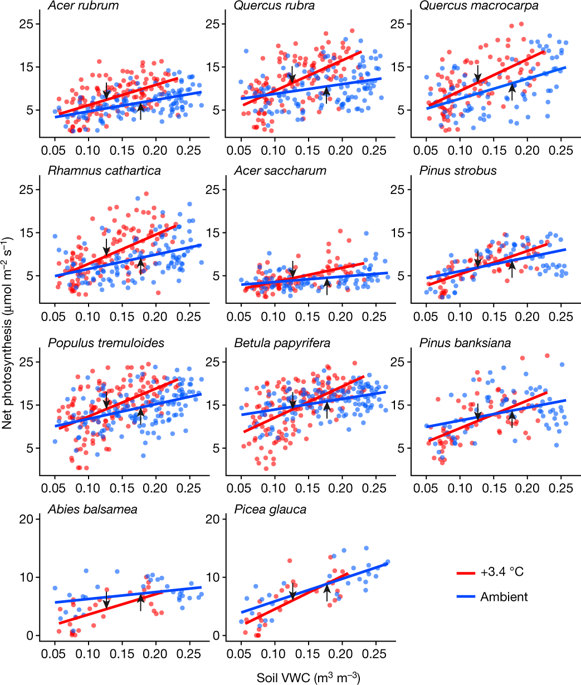Our official English website, www.x-mol.net, welcomes your feedback! (Note: you will need to create a separate account there.)
Effects of climate warming on photosynthesis in boreal tree species depend on soil moisture
Nature ( IF 64.8 ) Pub Date : 2018-10-01 , DOI: 10.1038/s41586-018-0582-4 Peter B. Reich , Kerrie M. Sendall , Artur Stefanski , Roy L. Rich , Sarah E. Hobbie , Rebecca A. Montgomery
Nature ( IF 64.8 ) Pub Date : 2018-10-01 , DOI: 10.1038/s41586-018-0582-4 Peter B. Reich , Kerrie M. Sendall , Artur Stefanski , Roy L. Rich , Sarah E. Hobbie , Rebecca A. Montgomery

|
Climate warming will influence photosynthesis via thermal effects and by altering soil moisture1–11. Both effects may be important for the vast areas of global forests that fluctuate between periods when cool temperatures limit photosynthesis and periods when soil moisture may be limiting to carbon gain4–6,9–11. Here we show that the effects of climate warming flip from positive to negative as southern boreal forests transition from rainy to modestly dry periods during the growing season. In a three-year open-air warming experiment with juveniles of 11 temperate and boreal tree species, an increase of 3.4 °C in temperature increased light-saturated net photosynthesis and leaf diffusive conductance on average on the one-third of days with the wettest soils. In all 11 species, leaf diffusive conductance and, as a result, light-saturated net photosynthesis decreased during dry spells, and did so more sharply in warmed plants than in plants at ambient temperatures. Consequently, across the 11 species, warming reduced light-saturated net photosynthesis on the two-thirds of days with driest soils. Thus, low soil moisture may reduce, or even reverse, the potential benefits of climate warming on photosynthesis in mesic, seasonally cold environments, both during drought and in regularly occurring, modestly dry periods during the growing season.Low soil moisture may reduce, or even reverse, the potential benefits of climate warming on photosynthesis in mesic, seasonally cold environments, both during drought and in regularly occurring, modestly dry periods during the growing season.
中文翻译:

气候变暖对北方树种光合作用的影响取决于土壤水分
气候变暖将通过热效应和改变土壤水分来影响光合作用1-11。对于在低温限制光合作用和土壤水分可能限制碳增加的时期之间波动的大片全球森林来说,这两种影响可能都很重要4-6,9-11。在这里,我们表明,随着南方北方森林在生长季节从多雨期过渡到适度干旱期,气候变暖的影响从正面转为负面。在对 11 种温带和寒带树种的幼鱼进行的为期三年的露天增温试验中,温度每升高 3.4 °C,在最潮湿的三分之一天里,平均光饱和净光合作用和叶片扩散导率都会增加。土壤。在所有 11 个物种中,叶子的扩散传导以及因此,在干旱期,光饱和的净光合作用减少,并且在温暖的植物中比在环境温度下的植物更显着。因此,在 11 个物种中,气候变暖在三分之二的土壤最干燥的日子里减少了光饱和的净光合作用。因此,低土壤水分可能会减少甚至逆转气候变暖对中等、季节性寒冷环境中光合作用的潜在益处,无论是在干旱期间还是在生长季节期间经常发生的适度干旱时期。 低土壤水分可能会降低,或甚至相反,气候变暖对中等、季节性寒冷环境中的光合作用的潜在益处,无论是在干旱期间还是在生长季节期间经常发生的适度干旱时期。并且在温暖的植物中比在环境温度下的植物中表现得更明显。因此,在 11 个物种中,气候变暖在三分之二的土壤最干燥的日子里减少了光饱和的净光合作用。因此,低土壤水分可能会减少甚至逆转气候变暖对中等、季节性寒冷环境中光合作用的潜在益处,无论是在干旱期间还是在生长季节期间经常发生的适度干旱时期。 低土壤水分可能会降低,或甚至相反,气候变暖对中等、季节性寒冷环境中的光合作用的潜在益处,无论是在干旱期间还是在生长季节期间经常发生的适度干旱时期。并且在温暖的植物中比在环境温度下的植物中表现得更明显。因此,在 11 个物种中,气候变暖在三分之二的土壤最干燥的日子里减少了光饱和的净光合作用。因此,低土壤湿度可能会减少甚至逆转气候变暖对中等、季节性寒冷环境中光合作用的潜在益处,无论是在干旱期间还是在生长季节期间经常发生的适度干旱时期。 低土壤湿度可能会降低,或甚至相反,气候变暖对中等、季节性寒冷环境中的光合作用的潜在益处,无论是在干旱期间还是在生长季节期间经常发生的适度干旱时期。在土壤最干燥的三分之二的日子里,变暖减少了光饱和的净光合作用。因此,低土壤湿度可能会减少甚至逆转气候变暖对中等、季节性寒冷环境中光合作用的潜在益处,无论是在干旱期间还是在生长季节期间经常发生的适度干旱时期。 低土壤湿度可能会降低,或甚至相反,气候变暖对中等、季节性寒冷环境中的光合作用的潜在益处,无论是在干旱期间还是在生长季节期间经常发生的适度干旱时期。在土壤最干燥的三分之二的日子里,变暖减少了光饱和的净光合作用。因此,低土壤湿度可能会减少甚至逆转气候变暖对中等、季节性寒冷环境中光合作用的潜在益处,无论是在干旱期间还是在生长季节期间经常发生的适度干旱时期。 低土壤湿度可能会降低,或甚至相反,气候变暖对中等、季节性寒冷环境中的光合作用的潜在益处,无论是在干旱期间还是在生长季节期间经常发生的适度干旱时期。
更新日期:2018-10-01
中文翻译:

气候变暖对北方树种光合作用的影响取决于土壤水分
气候变暖将通过热效应和改变土壤水分来影响光合作用1-11。对于在低温限制光合作用和土壤水分可能限制碳增加的时期之间波动的大片全球森林来说,这两种影响可能都很重要4-6,9-11。在这里,我们表明,随着南方北方森林在生长季节从多雨期过渡到适度干旱期,气候变暖的影响从正面转为负面。在对 11 种温带和寒带树种的幼鱼进行的为期三年的露天增温试验中,温度每升高 3.4 °C,在最潮湿的三分之一天里,平均光饱和净光合作用和叶片扩散导率都会增加。土壤。在所有 11 个物种中,叶子的扩散传导以及因此,在干旱期,光饱和的净光合作用减少,并且在温暖的植物中比在环境温度下的植物更显着。因此,在 11 个物种中,气候变暖在三分之二的土壤最干燥的日子里减少了光饱和的净光合作用。因此,低土壤水分可能会减少甚至逆转气候变暖对中等、季节性寒冷环境中光合作用的潜在益处,无论是在干旱期间还是在生长季节期间经常发生的适度干旱时期。 低土壤水分可能会降低,或甚至相反,气候变暖对中等、季节性寒冷环境中的光合作用的潜在益处,无论是在干旱期间还是在生长季节期间经常发生的适度干旱时期。并且在温暖的植物中比在环境温度下的植物中表现得更明显。因此,在 11 个物种中,气候变暖在三分之二的土壤最干燥的日子里减少了光饱和的净光合作用。因此,低土壤水分可能会减少甚至逆转气候变暖对中等、季节性寒冷环境中光合作用的潜在益处,无论是在干旱期间还是在生长季节期间经常发生的适度干旱时期。 低土壤水分可能会降低,或甚至相反,气候变暖对中等、季节性寒冷环境中的光合作用的潜在益处,无论是在干旱期间还是在生长季节期间经常发生的适度干旱时期。并且在温暖的植物中比在环境温度下的植物中表现得更明显。因此,在 11 个物种中,气候变暖在三分之二的土壤最干燥的日子里减少了光饱和的净光合作用。因此,低土壤湿度可能会减少甚至逆转气候变暖对中等、季节性寒冷环境中光合作用的潜在益处,无论是在干旱期间还是在生长季节期间经常发生的适度干旱时期。 低土壤湿度可能会降低,或甚至相反,气候变暖对中等、季节性寒冷环境中的光合作用的潜在益处,无论是在干旱期间还是在生长季节期间经常发生的适度干旱时期。在土壤最干燥的三分之二的日子里,变暖减少了光饱和的净光合作用。因此,低土壤湿度可能会减少甚至逆转气候变暖对中等、季节性寒冷环境中光合作用的潜在益处,无论是在干旱期间还是在生长季节期间经常发生的适度干旱时期。 低土壤湿度可能会降低,或甚至相反,气候变暖对中等、季节性寒冷环境中的光合作用的潜在益处,无论是在干旱期间还是在生长季节期间经常发生的适度干旱时期。在土壤最干燥的三分之二的日子里,变暖减少了光饱和的净光合作用。因此,低土壤湿度可能会减少甚至逆转气候变暖对中等、季节性寒冷环境中光合作用的潜在益处,无论是在干旱期间还是在生长季节期间经常发生的适度干旱时期。 低土壤湿度可能会降低,或甚至相反,气候变暖对中等、季节性寒冷环境中的光合作用的潜在益处,无论是在干旱期间还是在生长季节期间经常发生的适度干旱时期。



























 京公网安备 11010802027423号
京公网安备 11010802027423号